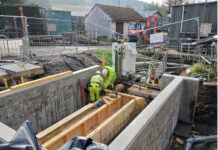
A CONTAMINATED land specialist took a novel approach to cleaning up the soil from an old printing works.
The site in Somerset had been contaminated with toluene over many years and developers wanted to extract the flammable solvent so the land could safely be used for housing. And in what is believed to be the first project of its kind, decontamination firm Provectus decided to dig out the soil and treat it above ground using a system of steam heating coils.
The contractor then brought in Spirax Sarco to design a steam distribution system to do the job. The conventional approach for toluene decontamination is to inject live steam into the ground to vaporise the volatile solvent but the local geology meant there was a risk that the toluene would migrate into the surrounding ground, rather than rising to the surface.
Provectus also judged that the 24-hectare site was too big to install an effective underground barrier around the operation to prevent such leaks escaping so decided to treat the soil ex-situ, where it could control the process more effectively.
“It meant we could homogenise the material better and improve the transmissivity,” said Provectus director Steve Langford. “It also prevented any contaminated vapour from migrating into the surrounding area through the fractured geology.”
In addition, using heating coils rather than direct steam injection was more efficient in terms of energy and water. Spirax Sarco advised using steam as the heating medium in the coils rather than hot water because it would remain at a constant temperature, rather than cooling down as it passed through the system.
Spirax Sarco engineers devised a series of trombone-shaped coils, laid flat across one of the old concrete factory floors. Several thousand metres of pipework were needed to provide a big enough heating area to treat the batches of soil that were piled on top.
Bristol contractor Engineering Services assembled the necessary pipework according to the Spirax Sarco design, complete with steam traps and associated controls to ensure that the system worked smoothly. The company also provided a 1250kW containerised boiler to generate the steam.
“It was quite a complex arrangement, but the biggest challenge for us was the physical site conditions,” explained Bob Clark, managing director of Engineering Services. “We were working exposed to the weather for the whole time.”
The process ran over four weeks, heating around 4,000m3 of material and collecting the resulting vapour in plastic sheeting. From there the solvent passed through a system of activated carbon beds, which absorbed the toluene before discharging clean air to the atmosphere.
“We’d never seen a project like this and neither had the Environment Agency personnel who inspected the operation,” said Langford. “We’d cleaned up the first batch of soil within two weeks and the site is now suitable for even the most sensitive developments, residential housing with gardens.”











